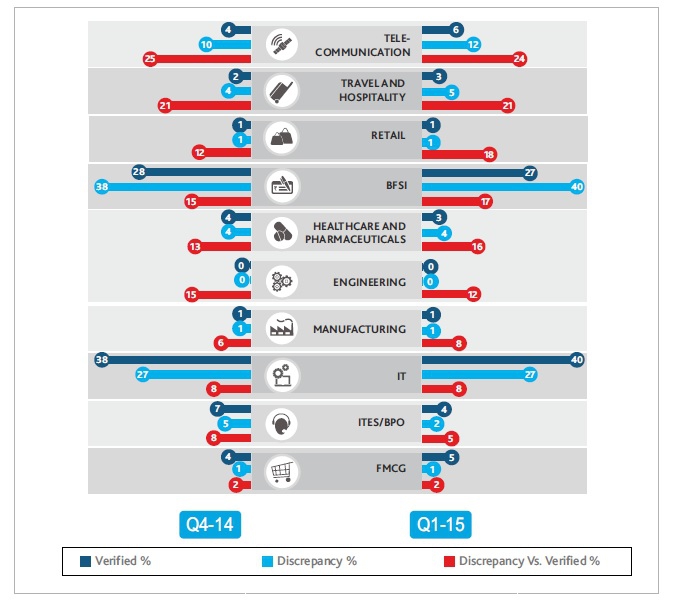Out of the total occurrences of discrepancies, a huge chunk of them have occurred in the employment component, followed by the address and education components.
Background screening of prospective employees has been the usual practice in sectors, such as IT, ITES, BFSI, manufacturing and FMCG. However, lately, even sectors such as retail, petroleum, travel & hospitality, healthcare, telecom, education and entertainment have woken up to the need to verify the claims made by job applicants before making the final offer. Even NGOs, research organisations and KPOs are following this practice in increasing numbers.
As background screening becomes more frequent in these new sectors, discrepancy in claims by candidates are also on the rise.
As per a report released by First Advantage, a company that specialises in background verification of potential employees, the share of discrepant cases is highest in sectors, such as telecom, travel & hospitality and retail.
Out of the total employee verification done by the company in the first quarter of 2015, only 6 per cent of cases were from the telecom sector. Despite this, the overall share of discrepant cases in telecom was 12 per cent.
In fact, out of the 100 cases verified in the telecom sector, 24 per cent were exaggerated or were false claims.

The good news though is that it has come down by one percentage point in comparison to Q4, 2014.
Next in the list is the travel & hospitality sector, where 21 per cent of total verified cases were found to be discrepant followed by retail, where 81 per cent of the verified cases were found to be false claims.
The discrepant cases in the BFSI, healthcare and pharma sectors, were 17 per cent and 16 per cent, respectively.
During this period, the maximum number of cases verified by First Advantage were from the IT sector at 40 per cent. This was followed by the BFSI sector at 27 per cent.
However, the trend for discrepancy in cases was exactly the opposite. Out of the 100 cases that were found to be false by the company, 40 were from BFSI and 27 were from IT.
In terms of age groups, candidates in the age group of 31–50 years were more frequent in terms of false claims at around 16 per cent. On the contrary, out of the 100 cases verified amongst the younger lot — below 21 and 22–30 age bracket— the false claims were only 8.3 and 11 per cent, respectively. The reason was because most of them had just started their career so did not have to manipulate their resumes.
Interestingly, FMCG and retail show a high discrepancy trend in the 31–40 years age bracket where BFSI, engineering, healthcare and pharmaceuticals show a high discrepancy trend in the 41–50 years age bracket.
Out of the total occurrences of discrepancies, a huge chunk of them have occurred in the employment component, followed by the address and education components. Discrepancy rates for employment and address checks are very high in the southern zone in India and education checks are very high in the northern zone.
City-wise, Bengaluru leads in employment and address-related discrepancies and New Delhi leads in education-related discrepancies.
Out of the total discrepant cases, 79 per cent were men and the remaining 21 per cent were women.
The overall recruitment process is getting expensive. Verifying a candidate’s background helps mitigate risk and saves the time and money involved in hiring a candidate with a fraudulent background.



